112/14/D4


Cookie Mold
Name/Title
Cookie Mold
Lexicon
Description
A parallelogram, 7 5/8" x 12 7/8" x 2 1/2" thick. The figure on the wood has been hand carved and resembles a gingerbread man. Made in the Wolcott, Vt. area, early 20th C.
Acquisition
Accession
1981.30
Made/Created
Dimensions
Entry/Object ID
1981.30


Maple Sugar Crystal
Name/Title
Maple Sugar Crystal
Description
Maple sugar crystal wrapped in a paper note that reads: "Maple Sugar crystal found in a 2 quart jar of low grade maple syrup put up in the early 1940s. When jar was emptied in 1974 this crystal was found. Elwin and Violet Davis, Gee Hill, Royalton, Vt." Note on the back of the paper reads: "brought in by John Powell, Groton, Vt. found at Gee Hill So. Royalton."
Acquisition
Accession
1982.33
Relationships
Related Places
Place
South Royalton
Village
Royalton
Town
Windsor County
County
Vermont
State/Province
United States of America
Country
North America
Dimensions
Materials
Material
Maple Sugar
Entry/Object ID
1982.33.13


Pennant
Name/Title
Pennant
Lexicon
Description
Blue felt pennant printed in white with a line drawing of a building and the inscription, "HOUSE O' MAPLE VERMONT SUGAR HOUSE ROYALTON, VERMONT". The short edge of the pennant is bound with white felt. The reverse is stamped in red with the mark, "The KEEZER MFG. Co. School of Artistic Specialties Plaistow, N.H. Made in U.S.A."
Acquisition
Accession
2010.11
Relationships
Related Person or Organization
House o' Maple
Person or Organization
Related Places
Place
Royalton
Town
Windsor County
County
Vermont
State/Province
United States of America
Country
North America
Made/Created
Date made
1966-1977
Manufacturer
The Keezer Manufacturing Co.
Dimensions
Dimension Description
Overall
Materials
Material
Wool
Entry/Object ID
2010.11.4
Context
Produced as a souvenir of the House o' Maple in Royalton, Vermont


Photograph
Name/Title
Photograph
Lexicon
Description
Photograph of maple sap collection with workhorses
Entry/Object ID
a-foto-maple-sapcollection
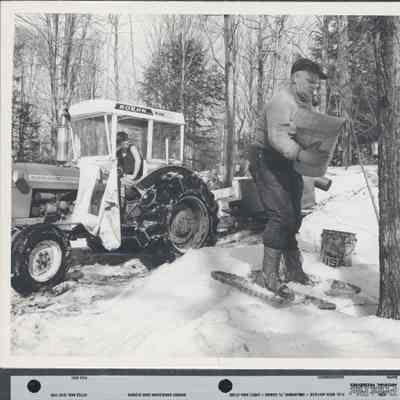

Photograph
Name/Title
Photograph
Lexicon
Description
Photograph of maple sap collection with a tractor
Entry/Object ID
a-foto-maple-sapcollection_002


Photograph
Name/Title
Photograph
Description
Photograph of F. B. Kellogg tapping a maple tree
Entry/Object ID
foto-maple-fbkelloggtapping


Sap Spiles
Name/Title
Sap Spiles
Lexicon
Description
Sumac twig, cut to fit into hole bored in maple tree. Sumac twig is naturally hollow
Use
Used for collecting maple sap
Made/Created
Date made
circa 1900
Materials
Material Notes
Sumac
Material
Wood
Entry/Object ID
L2024.3.41a-e


Sap Spout
Name/Title
Sap Spout
Lexicon
Description
Sap spout made from a tree branch. The bark of the branch has been roughly removed. The branch is cut in half lengthwise, leaving one end intact. That end is carved to a flattened point with a hole drilled through the center.
Acquisition
Accession
1953.57
Materials
Material
Wood
Entry/Object ID
1953.57.1


Sap Spout
Name/Title
Sap Spout
Lexicon
Description
Sap spout, silver colored, heavy metal. See diagram on Worksheet.
Acquisition
Accession
1982.32
Relationships
Related Places
Place
Ira
Town
Rutland County
County
Vermont
State/Province
United States of America
Country
North America
Dimensions
Materials
Material
Metal
Entry/Object ID
1982.32.3
Context
Used on the Lincoln farm in Ira, Vermont.


Sap Spout
Name/Title
Sap Spout
Lexicon
Description
Sap spout. Former number is FS-NE-S-10C
Acquisition
Accession
1982.32
Relationships
Related Places
Place
Ira
Town
Rutland County
County
Vermont
State/Province
United States of America
Country
North America
Dimensions
Materials
Material
Wood
Entry/Object ID
1982.32.13
Context
Used on the Lincoln farm in Ira, Vermont.


Sap Spout
Name/Title
Sap Spout
Lexicon
Acquisition
Accession
1982.33
Entry/Object ID
1982.33.4
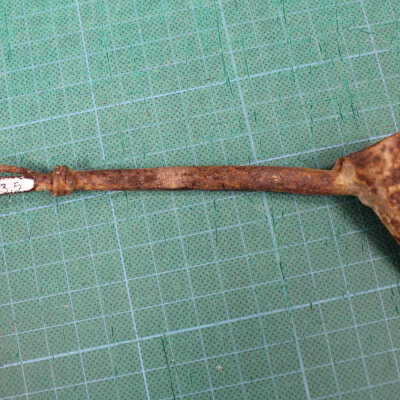

Sap Spout
Name/Title
Sap Spout
Lexicon
Acquisition
Accession
1982.33
Entry/Object ID
1982.33.5


Sap Spout
Name/Title
Sap Spout
Lexicon
Description
Long, curved metal sap spout with a wire wrapped around the narrow end.
Acquisition
Accession
1982.33
Materials
Material
Metal
Entry/Object ID
1982.33.7
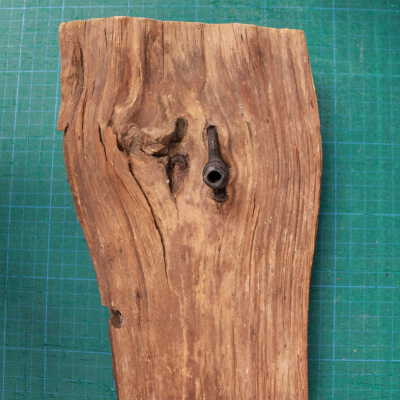

Sap Spout
Name/Title
Sap Spout
Lexicon
Acquisition
Accession
1982.33
Entry/Object ID
1982.33.14


Sap Spout
Name/Title
Sap Spout
Lexicon
Description
Metal spout (or spile) used for collecting sap from trees in order to make maple syrup. The spout is made of metal that is slightly curved, almost as if a completely cylindrical piece of metal was cut in half. There is a ridged lip on one end. Metal is a dark gray color with some rust on the inside. Object was clearly used.
Acquisition
Accession
1976.43
Dimensions
Materials
Material
Metal
Entry/Object ID
1976.43.255
Context
No known VT connection.


Sap Spout
Name/Title
Sap Spout
Lexicon
Description
Sap spout with small curved hook on bottom, meant for holding sap collecting/gathering bucket. Made of metal; stamped "WARNER" on one side and "PAT-D" on the other. Silver, slightly rusted from usage.
Acquisition
Accession
1976.43
Dimensions
Materials
Material
Metal
Entry/Object ID
1976.43.258
Context
No known VT connection.
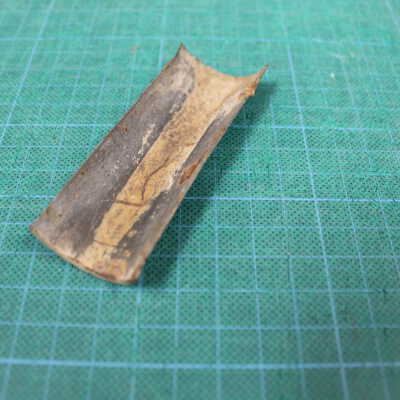

Sap Spout
Name/Title
Sap Spout
Lexicon
Description
A set of 3 spouts. Sheets of iron bent to form a trough along the length. One end (in section) has been filed to form a chisel point. The opposite end shows evidence of flattening from being hammered into a tree. This type of early sap spout was used with a bucket propped up against the tree or sitting on the ground. The chisel end of the spout made its own "hole" in the tree.
Acquisition
Accession
1982.14
Relationships
Related Places
Place
East Montpelier
Town
Washington County
County
Vermont
State/Province
United States of America
Country
North America
Entry/Object ID
1982.14.3
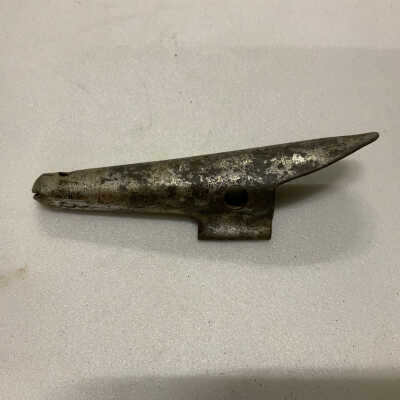

Sap Spout
Name/Title
Sap Spout
Lexicon
Description
Spouts for maple sugaring (card)
Acquisition
Accession
1966.15
Entry/Object ID
1966.15.29f


Spoon
Name/Title
Spoon
Lexicon
Description
Carved wooden spoon with scrolled handle. Stem and handle decorated with incised, floral decoration. Left edge of bowl shows significant wear.
Use
Maple sugar granulating spoon
Acquisition
Source (if not Accessioned)
Abenaki Cultural Conservancy
Ethnography
Made/Created
Date made
circa 1880
Materials
Material
Wood
Entry/Object ID
L2024.3.62
Context
This is an important piece from a “picker” in South-Central New Hampshire. It has a distinctive “semi-chip carved” foliar or vining design on the handle with more traditional chip carving on the sides of the fiddlehead handle. This distinctive regional Abenaki tool was used with a small bowl for turning hardening maple sugar into granules. The evidence for this use are the distinctive wood-compression grooves on the back of the neck, just above the spoon bowl. This was where the rim of the bowl was used as a fulcrum for the spoon to “jack” the hardening sugar away from the bottom of the bowl. The left side of bowl of the spoon was also heavily worn from stirring the hardening syrup. This piece is an excellent example of “use-wear” as evidence of the purpose of an artifact.